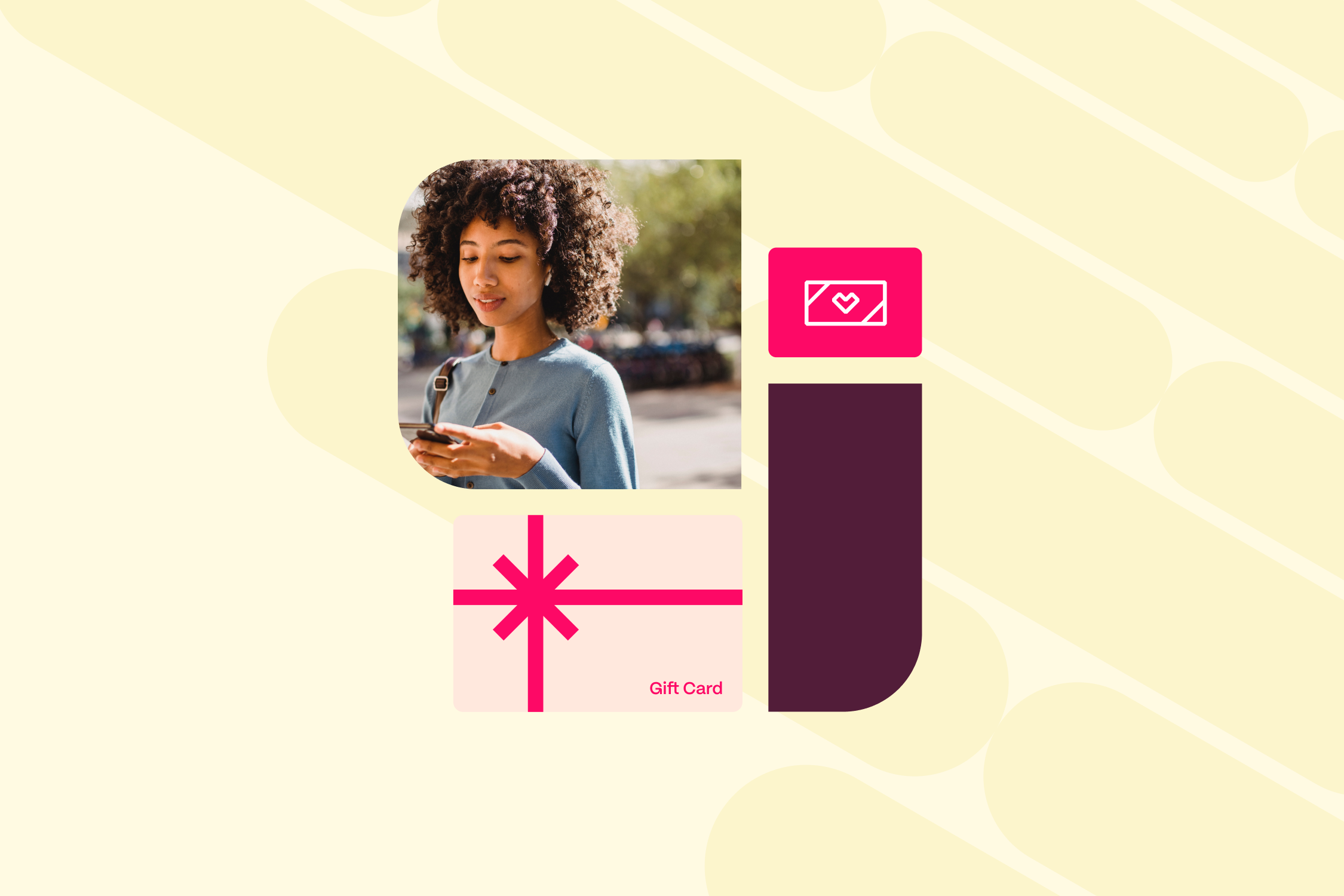In today’s competitive market, customer incentives aren’t a nice-to-have. They’re a strategic lever that can transform how customers interact with your brand - how often they buy, how loyal they are, and how likely they are to recommend your brand to others. But designing a program that actually moves the needle? That takes more than a quick discount code.
In this guide, we’ll explore different types of customer incentives - like gift cards, loyalty schemes and referral bonuses - along with practical examples and strategic insights. Whether you're trying to boost retention, improve acquisition, or simply show customers they matter, you’ll find ideas and guidance to help you build an incentive program that actually delivers results.
Index |
What are customer incentives?
Customer incentives are rewards or benefits offered to encourage a specific action or behaviour. At their core, they’re a way to influence decision-making - nudging customers toward choices that benefit both them and your business.
That action could be anything from signing up to a service, making a purchase, referring a friend, leaving a review, or simply staying loyal over time. The incentive is what makes it worth their while.
But customer incentives aren’t just about giving something away. Done right, they create a mutual value exchange. The customer gets something meaningful - whether it’s a gift card, a discount, or exclusive access. You get increased engagement, improved retention, and often a measurable boost in revenue.
They can take many forms, including:
- Financial rewards like money-off vouchers or prepaid gift cards
- Emotional rewards like recognition, status, or surprise-and-delight perks
- Experiential rewards such as early access, VIP content, or branded merchandise
Importantly, incentives aren’t one-size-fits-all. What motivates one segment of your audience might fall flat with another. That’s why smart businesses approach incentives strategically - choosing the right format, delivery method, and moment to make them count.
Why customer incentives matter
Customer incentives work because they tap into a simple truth: people respond to value. When that value is immediate, tangible, and personalised, it drives action. That action might be a purchase, a referral, a repeat visit, or even brand advocacy.
But beyond the psychology, there’s a business case. Incentives can:
- Increase conversion rates at key moments, such as checkout or onboarding
- Encourage repeat purchases and boost customer lifetime value
- Re-engage dormant customers with targeted rewards
- Strengthen brand loyalty, especially when tied to an ongoing scheme
- Drive referrals, reducing customer acquisition costs
The right incentive at the right time can shift behaviour and build deeper customer relationships. And increasingly, enterprise businesses are turning to more flexible, scalable options like physical & digital gift cards to do exactly that.
Types of customer incentives (with examples)
Let’s explore some of the most effective customer incentives being used today - along with where each one works best.
1. Gift cards and prepaid rewards
Gift cards are rising in popularity for a reason. They offer flexibility for customers and total control for businesses. Whether you’re rewarding loyalty, encouraging referrals, or nudging a prospect to convert, gift cards work across the customer journey.
Example:
A large online retailer uses branded prepaid gift cards to reward customers who leave product reviews. It boosts user-generated content and builds trust for future buyers. The cards are distributed digitally and redeemed in-store or online - no postage, no delays.
Why it works:
- Feels like a treat, not a discount
- Doesn’t devalue the product or brand
- Fully trackable and easy to manage via providers like Edenred Payment Solutions
Tip: Open loop gift cards (such as prepaid Mastercard® ones) are more versatile than store-specific ones, making them ideal for enterprise-scale programs with varied audiences.
Learn more: Launching and managing a gift card program
2. Loyalty programs
Traditional points-based schemes still work - especially when tiered or gamified. But it’s the emotional connection that makes them effective.
Example:
An airline uses a loyalty tier system where customers climb levels based on flight frequency and spend. Higher tiers offer not only free flights but exclusive lounge access and priority boarding. It taps into status and experience, not just cost savings.
Why it works:
- Builds long-term engagement
- Offers tangible and aspirational rewards
- Creates a “reason to stay”
3. Referral bonuses
People trust people. Referral schemes reward customers for spreading the word, helping brands tap into social proof and word-of-mouth growth.
Example:
A fintech startup offers a £20 gift card to both the referrer and the new customer when an account is opened. The incentive is clear, quick, and valuable to both sides.
Why it works:
- Doubles as an acquisition and retention strategy
- Clear reward for a simple action
- When effective, referral schemes can often be highly cost-effective compared to other acquisition strategies
4. Discounts and time-limited offers
Yes, they still work. Especially for new customers or cart abandoners. But be strategic - too many discounts can harm perceived value.
Example:
A subscription brand offers 10% off if a customer completes checkout within 30 minutes of abandoning their cart. Urgency and reward wrapped into one.
Why it works:
- Drives fast action
- Easy to test and personalise
- Ideal for price-sensitive segments
- High degree of control about who to offer it to
Building an effective incentive strategy
Throwing discounts at every customer won’t get you far. A successful program starts with strategy.
Step 1: Understand your audience
What motivates them? Price? Status? Flexibility? The same incentive won’t work for everyone. Segment your audience and tailor the approach.
Step 2: Set clear goals
Is the aim to drive new sign-ups, increase average order value, or reduce churn? Without specific goals, you won’t know if your program is working - or how to improve it.
Step 3: Choose the right incentive for the outcome
- Trying to re-engage churned users? A digital gift card may feel more personal than a blanket discount.
- Want to boost referrals? Make sure both parties get something of value.
- Looking to increase frequency of purchase? Consider a tiered loyalty program.
Step 4: Consider delivery and infrastructure
Here’s where many businesses fall short. Even the best-designed incentive won’t succeed if it’s hard to redeem or manage at scale.
Edenred Payment Solutions offers enterprise-grade infrastructure for digital and physical gift card incentives. You can:
- Issue branded prepaid cards (open or closed loop)
- Streamline delivery through API integrations
- Monitor usage and campaign performance
- Stay compliant and in control with real-time reporting
This is particularly important when running incentives across multiple regions, audiences, or touchpoints.
Step 5: Measure and optimise
Don’t just “set and forget.” Track redemptions, conversions, uplift in engagement, and longer-term behaviours. Then refine. Incentive strategies should evolve with your business.
Want to launch a successful gift card program?
If you’re considering gift cards as part of your customer incentive strategy, but aren’t sure where to start, Edenred Payment Solutions offers a free, on-demand online course designed specifically for enterprise teams.
In Develop a gift card program that’s right for your business, you’ll learn how to:
- Identify the most suitable gift card formats for your customer journey
- Design incentive flows that align with business goals
- Navigate operational, compliance, and technical considerations
- Build a business case for launching or scaling a gift card program
Whether you’re starting from scratch or optimising an existing setup, this course provides the strategic framework and practical insight needed to get it right.
Final thoughts
Customer incentives aren’t just about quick wins. When done well, they build lasting relationships, deepen customer engagement, and create brand advocates. And with flexible tools like prepaid gift cards, it's never been easier to design rewards that feel personal - without overcomplicating operations.
But strategy is everything. Know your audience. Align incentives to your goals. And work with partners who make delivery seamless.
If you’re looking to build or scale your incentive programme, Edenred Payment Solutions offers the infrastructure, flexibility, and expertise to make it happen.
Design, build, and launch your ideal gift card solution
With Edenred Payment Solutions as a trusted partner, retailers can unlock the full potential of their gift card initiatives, by leveraging our expertise and resources, to drive customer engagement and foster lasting brand loyalty.




.jpg?height=418&name=pexels-karolina-grabowska-4968391%20(1).jpg)